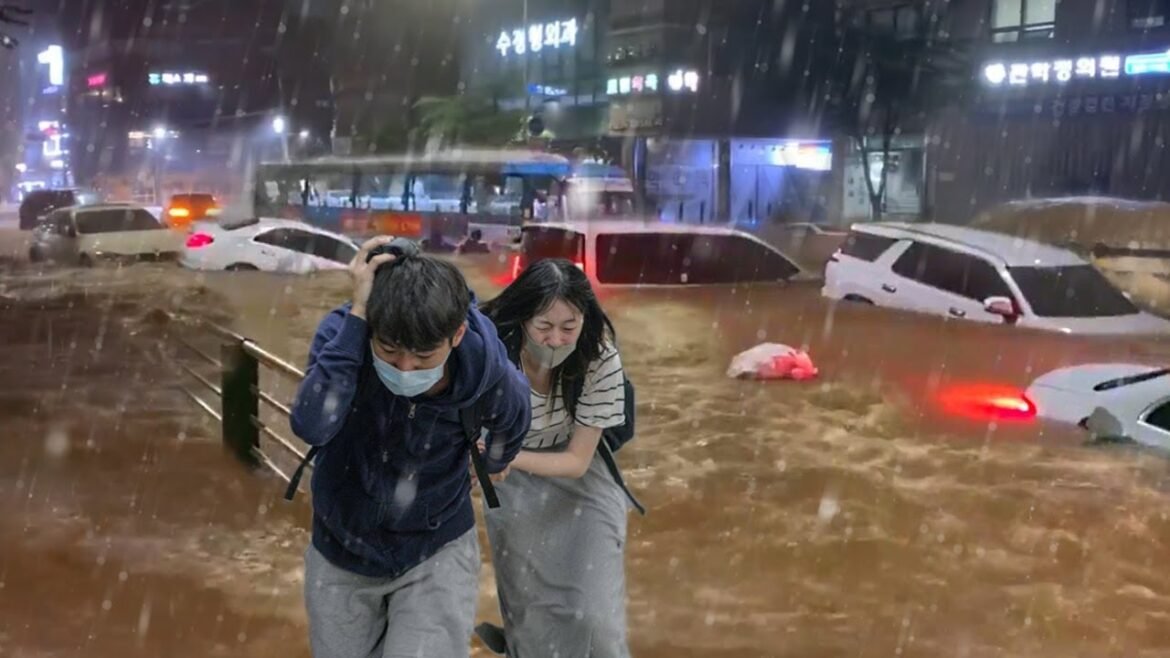This month, Asia has been ravaged by a relentless monsoon season, resulting in a tragic loss of over 100 lives across the region. The past two weeks have witnessed torrential downpours, triggering floods and landslides in countries such as South Korea, India, China, and Japan. The scale of devastation has forced hundreds of thousands of individuals to evacuate their homes.
In South Korea, the recent deluge led to the death of seven individuals and the displacement of thousands as flooding struck the nation. The capital city, Seoul, was particularly vulnerable, prompting high alert measures. Simultaneously, the Philippines faced the threat of a tropical cyclone, with authorities issuing warnings to the public.
Flood situations in Japan
Japan also encountered unprecedented floods earlier this week, specifically on the island of Kyushu. Tragically, at least eight individuals, including a local politician, lost their lives, while others remain unaccounted for. The meteorological agency in Japan expressed astonishment at the relentless rainfall, which shattered previous records across numerous cities.
Earlier in the week, Japanese authorities evacuated over 420,000 residents from two prefectures on Kyushu Island. Urgent orders were issued, emphasizing the imminent danger to lives and the need for immediate action.
Flood situation in South Korea
In Seoul, torrential rain struck the South Korean capital, leading to the evacuation of 135 individuals early on Friday last. The heavy downpour also caused power outages in approximately 4,000 households. Prime Minister Han Duck-soo, during an emergency meeting with government agencies, emphasized that preventing loss of life was the nation’s foremost priority. He urged all public officials to remain alert and responsive until the monsoon season concludes.
Additionally, Prime Minister Han warned officials to be thoroughly prepared for the potential release of water by North Korea from a dam near the inter-Korean border, as the country also experienced heavy rainfall. In the past, such releases have occurred without prior notice and resulted in flooding and fatalities in South Korea.
Situation in other countries
China and India have already endured several weeks of relentless downpours, leading to extensive damage in various regions. In northern India, nearly 100 fatalities have been reported over the past two weeks due to landslides, flash floods, and building collapses. The capital city of Delhi has faced significant challenges, with portions of the subway system being temporarily shut down, exacerbating the strain on already flooded roads in the country’s second most populous city. Online images and videos depict individuals stranded on inundated streets, wading through waist-high waters.

These occurrences underscore the urgent need to address climate change and implement measures to mitigate its effects, particularly in relation to extreme rainfall and the associated risks of flooding.
Exceptionally intense rainfall has claimed multiple lives and inflicted substantial damage on infrastructure throughout China. Striking footage emerged from Chongqing in the southwest, capturing the moment a building succumbed to the forceful currents and collapsed into a river.
In Cambodia’s capital, Phnom Penh, flash floods ensued after what officials described as the most substantial rainfall witnessed in three years. Approximately 14 districts in the city were adversely affected by the deluge.
Further south, the Philippines encountered heavy flooding during the morning rush hour on Thursday, resulting in a 17-kilometer (10-mile) traffic jam on a major highway leading to the capital, Manila. As a consequence, certain flights departing from Manila airport were canceled. Authorities anticipate the continuation of intense rainfall as a tropical cyclone ravages regions northeast of the capital.
Warning from Scientific Community
Scientists assert that climate change resulting from global warming has heightened the probability of intense rainfall worldwide, as a warmer atmosphere has the capacity to retain more moisture. This, combined with recent developments, highlights the concerning situation.
According to Stefan Uhlenbrook, the director of hydrology, water, and cryosphere at the World Meteorological Organization, developed countries like Japan demonstrate exceptional vigilance and possess well-established flood management measures. However, he noted that many low-income nations lack proper warning systems, adequate flood defenses, and comprehensive flood management strategies.
Last week, the World Meteorological Organization officially declared the onset of El Niño—a climatic phenomenon characterized by elevated sea surface temperatures in the tropical eastern Pacific exceeding the long-term average by at least 0.5 degrees Celsius. This declaration marks the first occurrence of El Niño in seven years. Consequently, global temperatures are anticipated to rise, accompanied by disruptive weather and climate patterns, according to the organization.


